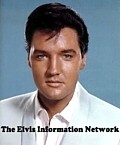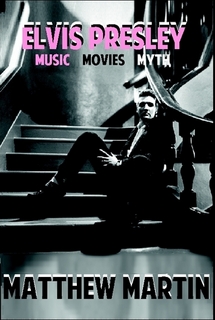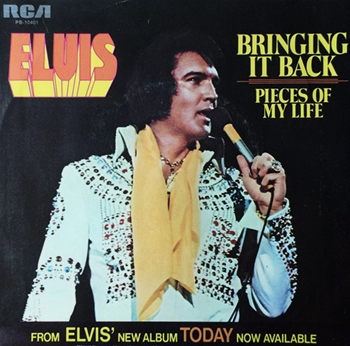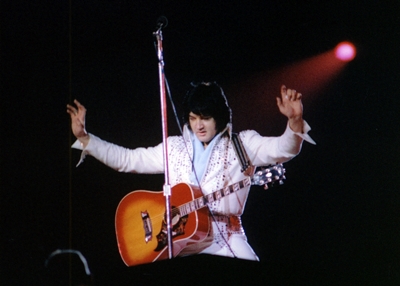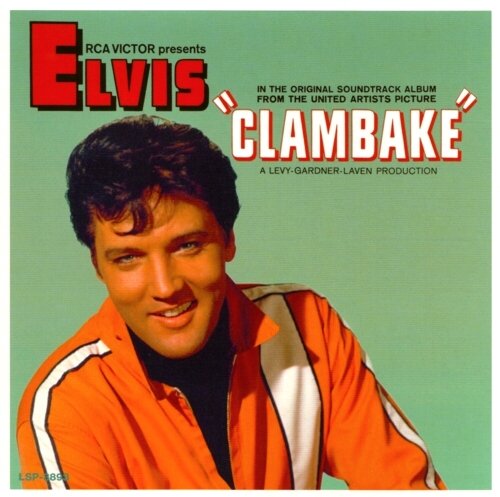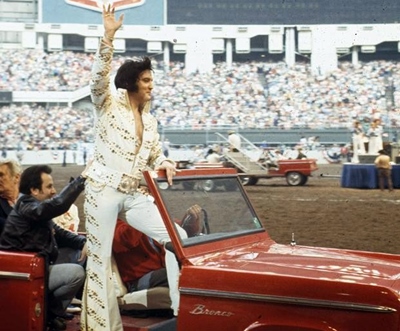| |
Book Review:
Elvis Presley
Music Movies Myth
Matthew Martin
Reviewed by Nigel Patterson, December 2018
|
Elvis Presley Music Movies Myth, Matthew Martin, BigPale Publishing, USA, 2018, Hardback (with dust jacket) 16 x 23.5cms, 414 pages, Not illustrated, ISBN-13: 978-1387241378
A little known book release in October 2018, and one worth investigating, is Matthew Martin’s hardcover examination of the Elvis story, Elvis Presley Music Movies Myth.
Martin appears to be a prolific, self-published(?) author, who has released numerous titles in the subject areas of religion and pop culture. He has an easy-going writing style and while it is difficult to present the Elvis story in terms different to what has already been printed in more than one thousand other Elvis biographies, Martin’s analysis is a neat one which reflects careful thought, as this critique of Elvis' post Army smash hit, Surrender, attests:
It's the most alien-arrangement a pop music song had experienced thus far. Half a decade before the Beatles were rewriting the book on song structure and what you could do with a melody, “Surrender” was throwing those rules out the window.
In relation to Elvis’ historic comeback, the narrative is measured:
As Elvis ended 1968, he did so with more optimism for the future than he’d had in nearly a decade. His film career was nearly finished, his TV special was drawing rave reviews, record sales were climbing and once again he was the talk of pop culture. Work still needed to be done, however, to maintain the momentum, not only as a music-artist but also as a celebrity.
The text is also measured when, about the sale of Elvis’ RCA back catalog in 1973, the author observes:
Other than specialty records such as his Gospel and Christmas albums, none of Elvis’ 1950’s or 1960’s music was selling with any consistency anymore.
When detailing what he considers to be Elvis’ best songs, Martin observes about the King’s studio recording of the classic, Bridge Over Troubled Water:
The radiating power in his voice when he reaches the song’s climax is chilling, and though the arrangement is bigger and bolder than in Simon and Garfunkel’s original, Elvis arguably (blasphemous though it is to say) out did theirs with his impassioned take. If you’ve never heard his version, you’re not the only one, but you owe it to yourself to hear it.
Offering the necessary balance to the strengths of how Elvis' music was managed, regarding the release of Bringin’ It Back as a single, the author is critical:
It fared even worse than T.R.O.U.B.L.E. however, reaching only #65.....The song is fine for the album, but there was nothing about it that justified releasing it as a single, especially not over the much-stronger “And I Love You So”. The only reason it seems they released it was because they had partial ownership of it, and it wasn’t a cover of an already released song.
Martin provides an in-depth analysis of Elvis’ 1975 New Year’s Eve concert at the Pontiac Silverdome in Detroit, including:
Elvis generally preferred not performing in stadium venues, despite two shows* at the Houston Astrodome, because the acoustics are different and the crowd is so far away again from the stage....
For starters, Elvis was in foul mood. The cold weather probably played a big part in that. He didn’t feel like doing a walk-through of the new Silverdome, and assumed the stage set-up would be comparable to the Houston Astrodome concert from 1974.......
Here, however, the (Silverdome) stage was two-tiered, with the backers placed on a lower level accessible by a rickety-looking stairway. Elvis, having skipped rehearsal, did not know about the change until he walked out onto the stage to sing the opening number. He looked around, while bowing to the audience, trying to find the rest of his band, and then when he discovered where they were, he shouted obscenities (all the while, the opening refrains of “See See Rider” was playing........
At another point the author expresses his disagreement with what some others have suggested:
There's a misconception that Elvis had no passion for recording rock songs after his split with Priscilla. Yet, whenever he had one to work with, he always tore into it with that same manic enthusiasm he gave to "That's All Right" a lifetime ago (or at least as much enthusiasm as his older, more worn down body would allow).
In support of his contention, Martin cites the recordings of Burning Love and T.R.O.U.B.L.E.
Commenting on the creative malaise that afflicted Elvis at times throughout his career, Martin encapsulates well how Elvis re-ignited his creative passions at critical times:
In the past, whenever the performer needed a musical spark to rekindle his cultural relevance, he found it by changing up his status quo. It worked in 1966 with the How Great Thou Art session. It worked in 1969 with Chips Moman’s American Sound recordings. Elvis hoped it would work again by recording at the legendary Stax studio in Memphis, just five miles up Highway 51 from his Graceland mansion.
In relation to Elvis’ celluloid career, Martin provides a well modulated appreciation (both positive and negative) of Elvis' film output. Regarding Clambake, he is insightfully observes:
Clambake saw Elvis playing a son who rebels against the arranged plans of his father, and oil tycoon. Let's pause and consider the fact that Elvis was over thirty-years old and was playing a role that would have been right at home with someone almost half his age.
Importantly, Martin identifies two issues, one around the lasting impact of most of his film and the other the key element which helped make some of his films more popular than others:
Blue Hawaii is fourth movie of the 1960’s and second film released in 1961, but for many it was his second movie after the Army. So many of his films failed to leave a lasting impression but a few have stayed memorable. Blue Hawaii is remembered alongside others like Jailhouse Rock and Viva Las Vegas as movies of Elvis that anyone can identify. A large part of its continued standing is due to the fourteen-track album that accompanied the film’s release.
The author's perspective about Elvis in 1977 prior to his death is one which will rankle many fans - however, it is one deserving of close consideration:
Elvis' life was not even a joke in 1977; it wasn't important enough to comment on to joke about. He was beyond a punchline. He was forgotten.
Matthew Martin’s consideration of the Elvis story is presented in chronological order starting with the year 1953 and ending with the chapter, 1978. There are no photos, index, or author bio.
However, Elvis Presley Music Movies Myth also contains a number of thematic appendices. These include:
- A brief consideration of each of Elvis’ 49 RCA albums released between 1956 and 1977 (the author lists them in descending order of worst to best)
- Who Really Was “Colonel Tom Parker?”
- On Sam and Sun and the Nativity of Rock and Roll
- Every Elvis Movie, Ranked from Worst to First
- The Best Elvis Songs
While the book contains more than 400 pages, it could have been printed with less than 300, as each page has wide left and right borders and the narrative lines are double spaced.
Verdict: Matthew Martin has written an entertaining, insightful and easy-to-read consideration of the Presley phenomenon, one in which Elvis’ music, movies and his myth are well covered. With a balanced and strong story to tell, and a reasonable price tag around US$26.00 (exclusive of postage), Elvis Presley Music Movies Myth positions itself as a solid entry in the biographical space between the highly detailed offerings of Peter Guralnick, et al, and the minimalist “quickie” biographies which generally lack research, substance or insight.
*..EIN note: Elvis played eight shows at the Astrodome (six in 1970 and two in 1974)
Copyright the Elvis Information Network.
Elvis Presley, Elvis and Graceland are trademarks of Elvis Presley Enterprises.
The Elvis Information Network has been running since 1986 and is an EPE officially recognised Elvis fan club.
|
|
|
|



